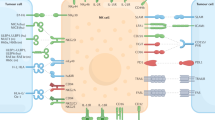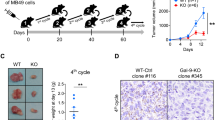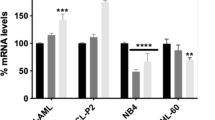Abstract
Natural killer (NK) cells are lymphoid effector cells possessing spontaneous cytolytic activity against a variety of tumour targets1. The fact that NK cells pre-exist at high frequency and require no lengthy activation, and the observation that differentiated and metastatic tumour cells often have a decreased sensitivity to NK cytolysis have led to the hypothesis that these cells may be involved in the earliest stages of antitumour surveillance2. Central to this model is the prediction that NK sensitivity must arise during cellular transformation. To test this prediction directly, we have constructed a vector containing the transforming gene from the EJ bladder carcinoma cell line under the transcriptional control of the mouse metallothionein-I promoter. When induced with heavy metal ions, mouse fibroblast lines containing this vector become dramatically sensitive to NK-mediated cytolysis concomitant with the expression of the cellular Harvey ras (c-Ha-ras) p21 protein and with cellular transformation.
This is a preview of subscription content, access via your institution
Access options
Subscribe to this journal
Receive 51 print issues and online access
$199.00 per year
only $3.90 per issue
Buy this article
- Purchase on Springer Link
- Instant access to full article PDF
Prices may be subject to local taxes which are calculated during checkout
Similar content being viewed by others
References
Kiessling, R., Klein, E. & Wigzell, H. Eur. J. Immun. 5, 112–117 (1975).
Herberman, R. & Ortaldo, J. Science 214, 24–30 (1981).
Shih, C. & Weinberg, R. A. Cell 29, 161–169 (1982).
Southern, P. J. & Berg, P. J. molec. appl. Genet. 11, 327–341 (1982).
Durnam, D. M. et al. Proc. natn. Acad. Sci. U.S.A. 77, 6511–6515 (1980).
Brinster, R. L. et al. Nature 296, 39–42 (1982).
Palmiter, R. D. et al. Nature 300, 611–615 (1982).
Reznikoff, C. A., Brankow, D. W. & Heidelberger, C. Cancer Res. 33, 3231–3238 (1973).
Capon, D. J. et al. Nature 302, 33–37 (1983).
Furth, M. E. et al. J. Virol. 43, 294–304 (1982).
Brooks, C. G., Kuribayashi, K., Sale, G. E. & Henney, C. S. J. Immun. 128, 2326–2335 (1982).
Roder, J. C. & Duwe, A. Nature 278, 451–453 (1979).
Burton, R. C. & Winn, H. J. J. Immun. 126, 1985–1989 (1981).
Kasai, M., Iwamori, Y., Nagai, Y., Okamura, K. & Tada T. Eur. J. Immun. 10, 175–180 (1980).
Collins, J. L., Patek, P. Q. & Cohn, M. J. exp. Med. 153, 89–106 (1981).
Parada, L. F. & Weinberg, R. A. Molec. cell. Biol. 3, 2298–2301 (1983).
Norrander, J., Kempe, T. & Messing, J. Gene 26, 101–106 (1983).
Glanville, N., Durnam, D. M. & Palmiter, R. D. Nature 292, 267–269 (1981).
Ochi, A. et al. Nature 302, 340–342 (1983).
Chirgwin, J. M. et al. Biochemistry 18, 5294–5299 (1979).
Thomas, P. S. Proc. natn. Acad. Sci. U.S.A. 77, 5201–5205 (1980).
Laemmli, U. K. Nature 227, 680–685 (1970).
Author information
Authors and Affiliations
Rights and permissions
About this article
Cite this article
Trimble, W., Johnson, P., Hozumi, N. et al. Inducible cellular transformation by a metallothionein-ras hybrid oncogene leads to natural killer cell susceptibility. Nature 321, 782–784 (1986). https://doi.org/10.1038/321782a0
Received:
Accepted:
Issue Date:
DOI: https://doi.org/10.1038/321782a0
This article is cited by
-
Hyaluronan and cell locomotion
Cancer and Metastasis Review (1992)
-
ras Transfection and expression does not induce progression from tumorigenicity to metastatic ability in mouse LTA cells
Clinical & Experimental Metastasis (1990)
-
The in vivo clearance of Ha-ras transformants by natural killer cells
Clinical & Experimental Metastasis (1990)
-
Use of NeoR B16F1 murine melanoma cells to assess clonality of experimental metastases in the immune-deficient chick embryo
Clinical & Experimental Metastasis (1988)
-
Morphological transformation and tumorigenicity in C3H/10T1/2 cells transformed with an inducible c-Ha-ras oncogene
Bioscience Reports (1987)
Comments
By submitting a comment you agree to abide by our Terms and Community Guidelines. If you find something abusive or that does not comply with our terms or guidelines please flag it as inappropriate.



